Art
A Minnesota University Is Under Fire for Dismissing an Art History Professor Who Showed Medieval Paintings of depicting the Prophet Muhammad
In a controversial move, an adjunct professor at Hamline University in St. Paul, Minnesota, has lost her job after showing her class Medieval paintings depicting the Prophet Muhammad, founder of the Islamic religion.
The school’s decision not to renew the professor’s contract for the current semester has sparked debates over free speech, including a Change.org petition in support of the teacher, signed by at least 2,500 scholars and students of Islamic studies and art history, and a condemnation from PEN America of the “egregious violation” of academic freedom.
Though it is not mentioned in the Koran, many Muslims believe it is idolatrous to show Muhammad’s face. Most mosques instead are decorated with geometric designs and calligraphy featuring passages from the Koran, and Islamic figurative art is now rare.
But there is also a tradition of painting Muhammad, often in miniature, especially in Persia, Turkey, and India. Examples can be found in the collections of museums such as the Louvre, the Metropolitan Museum of Art, and the Asian Art Museum of San Francisco. It was a selection of two of those artworks shown to the class that cost the professor her job.
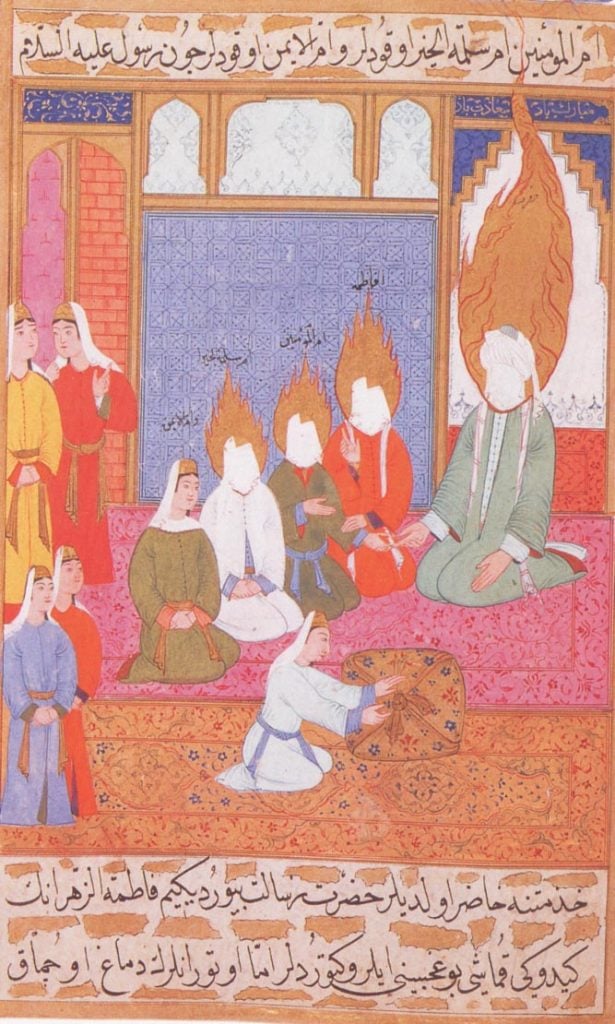
Mustafa ibn Vali, illustration of Muhammad in The Life of the Prophet (Siyer-i nebi), ca. 1594–95. Collection of the Chester Beatty Library.
The teacher, identified by the Art Newspaper as Erika Lopez Prater, is said to have displayed the images during on online lecture on October 6, 2022. There was a two-minute content warning prior to the artworks’ appearance, to allow students to opt out of viewing the potentially offensive imagery should they feel it was against their faith.
“I am showing you this image for a reason,” Prater said before changing the slide, as reported by the university’s student paper, the Oracle. “And that is that there is this common thinking that Islam completely forbids, outright, any figurative depictions or any depictions of holy personages. While many Islamic cultures do strongly frown on this practice, I would like to remind you there is no one, monothetic Islamic culture.”
One of the artworks was an illustration of the archangel Gabriel delivering his revelations to Muhammad from a 14th-century manuscript by Rashīd al-Dīn called the Compendium of Chronicles, while the other was a 16th-century work by Mustafa ibn Vali showing the prophet with a veil and halo.
Aram Wedatalla, a student in the class and the president of the university’s Muslim Student Association, complained to the professor afterward. Prater apologized in an email, but Wedatalla elevated the issue to university administrators, arguing that the lesson was disrespectful to Muslim students.
In response, the dean of students sent an email to the student body condemning the incident as “undeniably inconsiderate, disrespectful, and Islamophobic.”
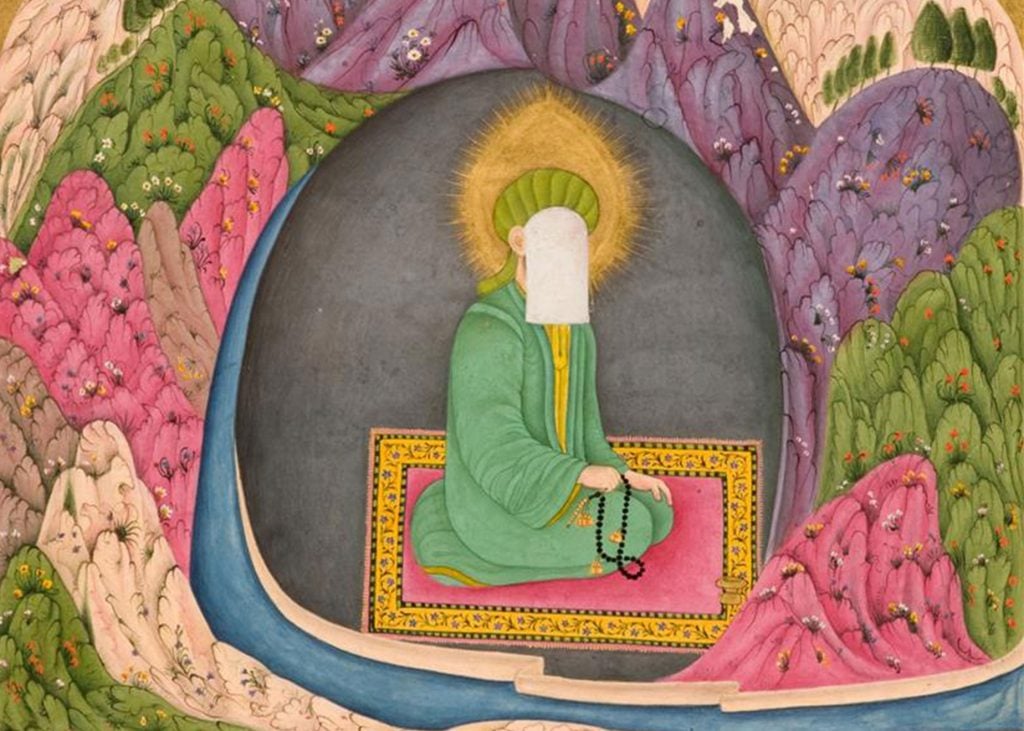
The prophet Muhammad in the cave of Hira, page from a Hamla-yi Haidari manuscript (ca. 1725). Asian Art Museum of San Francisco, gift of George Hopper Fitch.
On December 6, two articles on the incident were published in the Oracle—one a news report in which the university’s associate vice president of inclusive excellence David Everett said that “it was decided it was best that this faculty member was no longer part of the Hamline community.”
“My perspective and actions have been lamentably mischaracterized, my opportunities for due process have been thwarted, and Dr. Everett’s all-employee email accusation that ‘undeniably… Islamophobic’ actions undertaken in my class on Oct. 6 have been misapplied,” Prater told the student paper.
The other Oracle article was a letter to the editor from Mark Berkson, the university’s department of religion chair and a professor of Asian religions, Islam, and comparative religion.
“In the context of an art history classroom, showing an Islamic representation of the Prophet Muhammad, a painting that was done to honor Muhammad and depict an important historical moment, is not an example of Islamophobia,” he wrote. “Labeling it this way is not only inaccurate but also takes our attention off of real examples of bigotry and hate.”
The Oracle editorial board removed the article from its website just two days after its publication. (Berkson’s text is currently available on the libertarian magazine Reason, along with both emails from administrators to the university community.)
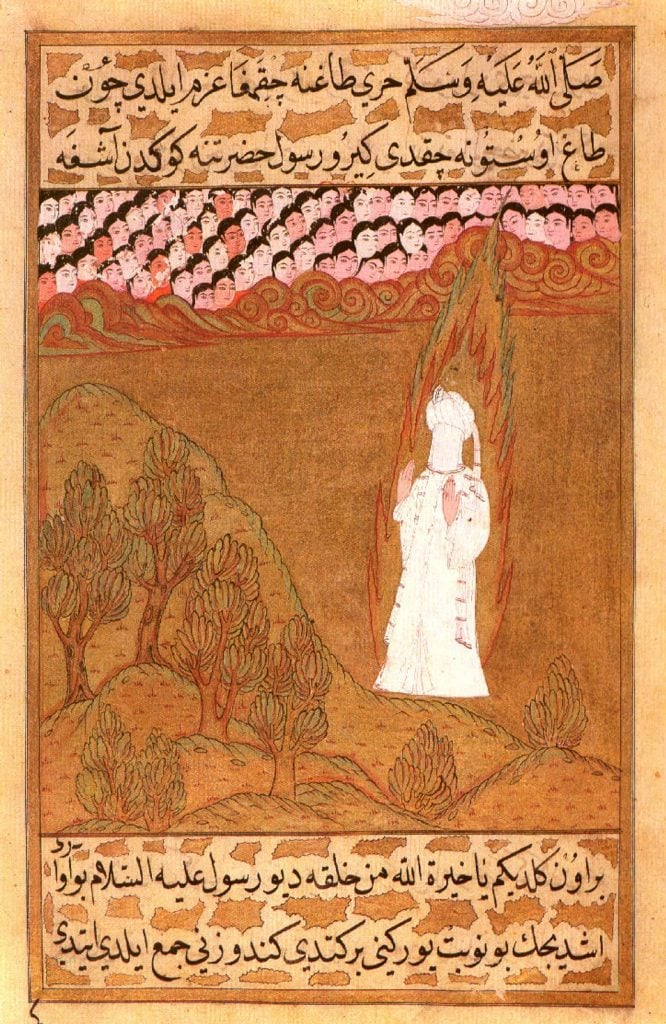
The Islamic prophet Muhammad (figure without face) on Mount Hira. Ottoman miniature painting from the Siyer-i Nebi. Collection of the Topkapı Sarayı Müzesi, Istanbul.
“Those in our community have expressed that a letter we published has caused them harm,” the Oracle wrote in explanation of the decision. “Our publication will not participate in conversations where a person must defend their lived experience and trauma as topics of discussion or debate.”
The following day, a second university-wide email went out, from Everett and university president Fayneese Miller. It said that “respect for the observant Muslim students in that classroom should have superseded academic freedom.”
“Displaying an image of Muhammad may similarly be deeply offensive to some, but because it was pedagogically relevant to the course at issue, it is protected by basic tenets of academic freedom,” Sabrina Conza, the program officer of the Foundation for Individual Rights and Expression (FIRE), countered in an open letter to Miller, expressing the organization’s concern about the incident and calling for Prater to be reinstated.
The university had held a 33-person meeting about the incident on November 10, with Everett and other administrators such as the dean of students, the interim provost, the assistant director of social justice programs, and the university chaplain among those in attendance, as well as a number of students.
“Of all of the conversations that were held between the MSA and the administration about what to do about the situation, the faculty member was excluded and not a single scholarly voice was ever included,” Berkson told Hyperallergic. “So nobody in the room actually knew anything about these images.”
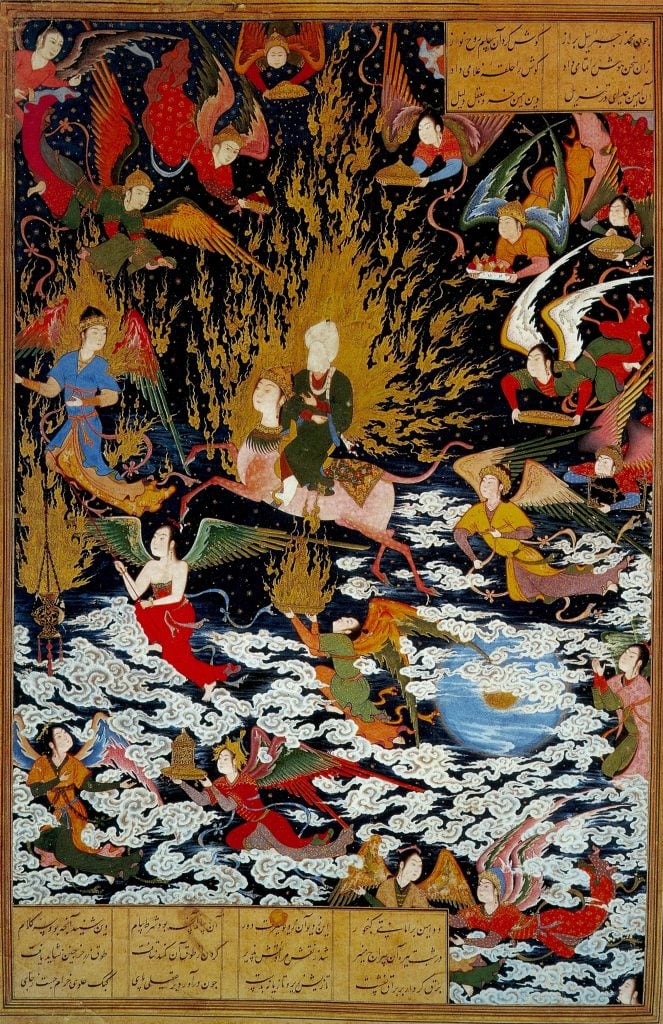
Persian miniature 1550 AD depicting the Prophet Muhammad ascending on the Burak into Heaven, a journey known as the Miraj. Photo by Universal History Archive/Getty Images.
“These images are a part of Islamic artistic tradition, and it is very important for us to appreciate and study. That’s what art historians do,” Berkson added. “If specific students don’t want to look at it, that is an important right. I think we should have a protocol to ensure that no student’s religious prohibitions are violated. But their prohibition cannot be imposed on everyone else.”
Representatives for Hamline University did not respond to a request for comment.
To address concerns among the university’s Muslim community, Hamline reportedly invited Jaylani Hussein, executive director of Minnesota’s chapter of the Council on American-Islamic Relations, to the school to lead a conversation about Islamophobia in December.
“Many of the Muslim students on campus, after they heard of this incident, it impacted them. It impacted their grades, it impacted them finishing off the semester. They obviously were hurt. At the same time, they’re appreciative of the institution doing the right thing,” Hussein told Twin Cities Pioneer Press last month. “For us Muslims, it is blasphemy.”
News of the professor’s termination was first reported outside the university in New Lines Magazine by Christiane Gruber, an art historian who specializes in depictions of Muhammad.
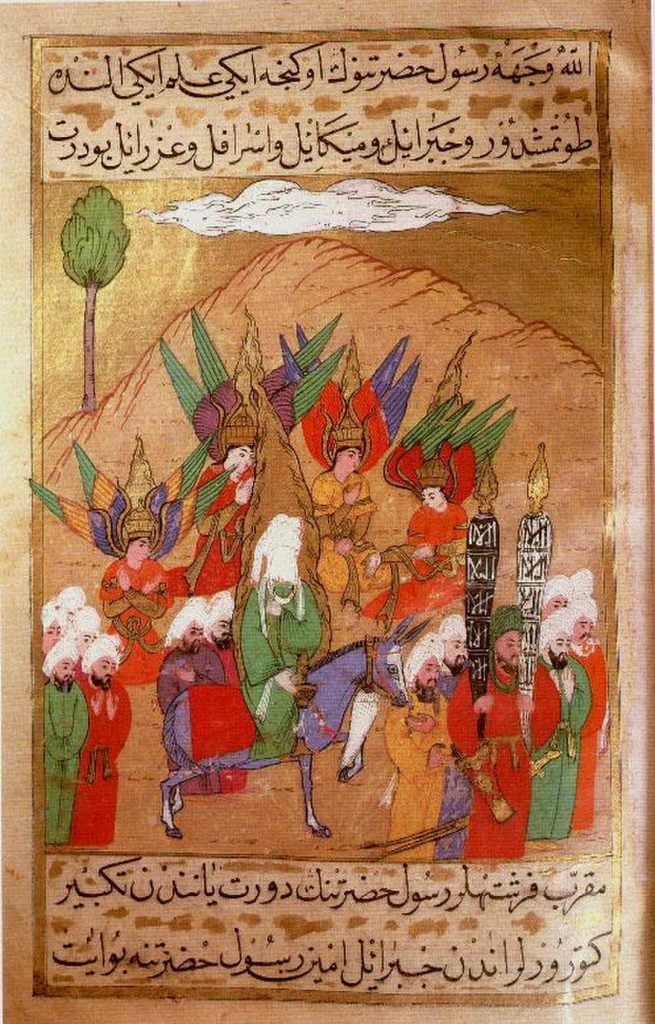
The Prophet Muhammad and his companions advancing on Mecca, attended by the angels Gabriel, Michael, Israfil and Azrail, from Siyer-i Nebi: The Life of the Prophet (1595).
“Hamline administrators have labeled this corpus of Islamic depictions of Muhammad, along with their teaching, as hateful, intolerant, and Islamophobic. And yet the visual evidence proves contrary: The images were made, almost without exception, by Muslim artists for Muslim patrons in respect for, and in exaltation of, Muhammad and the Quran,” Gruber wrote.
“Through conflation or confusion, Hamline has privileged an ultraconservative Muslim view on the subject that happens to coincide with the age-old Western cliche that Muslims are banned from viewing images of the prophet,” she added, noting that this “muzzles all other voices while potentially endangering rare and precious works of Islamic art.”
“If these reports are accurate, Hamline University has committed one of the most egregious violations of academic freedom in recent memory,” Jeremy Young, senior manager of free expression and education at PEN America, said in a statement.
“Not only is an art history professor well within their rights to show medieval and Renaissance Islamic artworks in class,” he added, “but the professor apparently took added care to create a positive pedagogical experience for students—placing the images in historical context, allowing students to opt out of viewing them, and thoughtfully exploring the history and diversity of Islamic art and thought.”
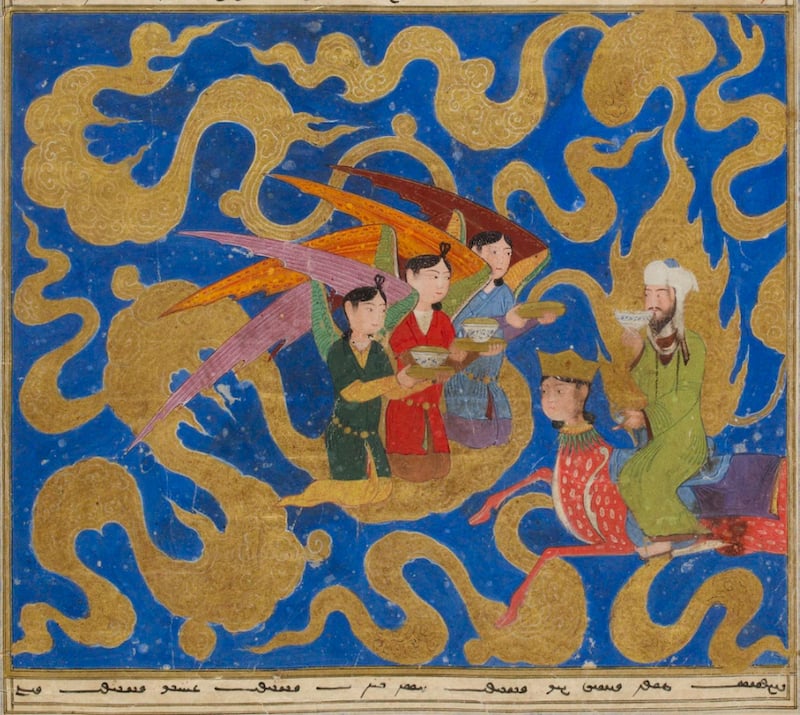
The ascension of the prophet Muhammad depicted in the Miraj Nameh manuscript (1436).
The Academic Freedom Alliance also published a letter in support of Prater, calling for her immediate reinstatement.
“If a professor of art history cannot show college students significant works of art for fear that offended students or members of the community could get that professor fired for doing so, then there simply is no serious commitment to academic freedom at that institution—and indeed no serious commitment to higher education,” Keith Whittington, a member of the alliance’s academic committee and a professor of politics at Princeton University, wrote in the letter.
In another email to the Hamline community on December 31, the university president continued to defend the decision not to renew Prater’s contract.
“It was important that our Muslim students, as well as all other students, feel safe, supported, and respected both in and out of our classrooms,” Miller wrote, according to Pioneer Press. “It is also important that we clarify that the adjunct instructor was teaching for the first time at Hamline, received an appointment letter for the fall semester, and taught the course until the end of the term.”
In response, FIRE filed a complaint with the Higher Learning Commission on January 4, asking that the organization hold the university accountable for violating accreditation standards regarding academic freedom.
“We gave Hamline plenty of time to reverse course, but it’s clear they’re not planning to deliver on their academic freedom promises,” FIRE attorney Alex Morey, who wrote the complaint, said in a statement.
“Hamline has no right to dismiss an art history instructor for teaching art history,” Conza added. “Hamline clearly doesn’t understand what academic freedom means, even though it explicitly promises faculty this core right.”

Art
Calvin Lucyshyn: Vancouver Island Art Dealer Faces Fraud Charges After Police Seize Millions in Artwork

In a case that has sent shockwaves through the Vancouver Island art community, a local art dealer has been charged with one count of fraud over $5,000. Calvin Lucyshyn, the former operator of the now-closed Winchester Galleries in Oak Bay, faces the charge after police seized hundreds of artworks, valued in the tens of millions of dollars, from various storage sites in the Greater Victoria area.
Alleged Fraud Scheme
Police allege that Lucyshyn had been taking valuable art from members of the public under the guise of appraising or consigning the pieces for sale, only to cut off all communication with the owners. This investigation began in April 2022, when police received a complaint from an individual who had provided four paintings to Lucyshyn, including three works by renowned British Columbia artist Emily Carr, and had not received any updates on their sale.
Further investigation by the Saanich Police Department revealed that this was not an isolated incident. Detectives found other alleged victims who had similar experiences with Winchester Galleries, leading police to execute search warrants at three separate storage locations across Greater Victoria.
Massive Seizure of Artworks
In what has become one of the largest art fraud investigations in recent Canadian history, authorities seized approximately 1,100 pieces of art, including more than 600 pieces from a storage site in Saanich, over 300 in Langford, and more than 100 in Oak Bay. Some of the more valuable pieces, according to police, were estimated to be worth $85,000 each.
Lucyshyn was arrested on April 21, 2022, but was later released from custody. In May 2024, a fraud charge was formally laid against him.
Artwork Returned, but Some Remain Unclaimed
In a statement released on Monday, the Saanich Police Department confirmed that 1,050 of the seized artworks have been returned to their rightful owners. However, several pieces remain unclaimed, and police continue their efforts to track down the owners of these works.
Court Proceedings Ongoing
The criminal charge against Lucyshyn has not yet been tested in court, and he has publicly stated his intention to defend himself against any pending allegations. His next court appearance is scheduled for September 10, 2024.
Impact on the Local Art Community
The news of Lucyshyn’s alleged fraud has deeply affected Vancouver Island’s art community, particularly collectors, galleries, and artists who may have been impacted by the gallery’s operations. With high-value pieces from artists like Emily Carr involved, the case underscores the vulnerabilities that can exist in art transactions.
For many art collectors, the investigation has raised concerns about the potential for fraud in the art world, particularly when it comes to dealing with private galleries and dealers. The seizure of such a vast collection of artworks has also led to questions about the management and oversight of valuable art pieces, as well as the importance of transparency and trust in the industry.
As the case continues to unfold in court, it will likely serve as a cautionary tale for collectors and galleries alike, highlighting the need for due diligence in the sale and appraisal of high-value artworks.
While much of the seized artwork has been returned, the full scale of the alleged fraud is still being unraveled. Lucyshyn’s upcoming court appearances will be closely watched, not only by the legal community but also by the wider art world, as it navigates the fallout from one of Canada’s most significant art fraud cases in recent memory.
Art collectors and individuals who believe they may have been affected by this case are encouraged to contact the Saanich Police Department to inquire about any unclaimed pieces. Additionally, the case serves as a reminder for anyone involved in high-value art transactions to work with reputable dealers and to keep thorough documentation of all transactions.
As with any investment, whether in art or other ventures, it is crucial to be cautious and informed. Art fraud can devastate personal collections and finances, but by taking steps to verify authenticity, provenance, and the reputation of dealers, collectors can help safeguard their valuable pieces.
Art
Ukrainian sells art in Essex while stuck in a warzone – BBC.com
[unable to retrieve full-text content]
Ukrainian sells art in Essex while stuck in a warzone BBC.com

Source link
Art
Somerset House Fire: Courtauld Gallery Reopens, Rest of Landmark Closed
The Courtauld Gallery at Somerset House has reopened its doors to the public after a fire swept through the historic building in central London. While the gallery has resumed operations, the rest of the iconic site remains closed “until further notice.”
On Saturday, approximately 125 firefighters were called to the scene to battle the blaze, which sent smoke billowing across the city. Fortunately, the fire occurred in a part of the building not housing valuable artworks, and no injuries were reported. Authorities are still investigating the cause of the fire.
Despite the disruption, art lovers queued outside the gallery before it reopened at 10:00 BST on Sunday. One visitor expressed his relief, saying, “I was sad to see the fire, but I’m relieved the art is safe.”
The Clark family, visiting London from Washington state, USA, had a unique perspective on the incident. While sightseeing on the London Eye, they watched as firefighters tackled the flames. Paul Clark, accompanied by his wife Jiorgia and their four children, shared their concern for the safety of the artwork inside Somerset House. “It was sad to see,” Mr. Clark told the BBC. As a fan of Vincent Van Gogh, he was particularly relieved to learn that the painter’s famous Self-Portrait with Bandaged Ear had not been affected by the fire.
Blaze in the West Wing
The fire broke out around midday on Saturday in the west wing of Somerset House, a section of the building primarily used for offices and storage. Jonathan Reekie, director of Somerset House Trust, assured the public that “no valuable artefacts or artworks” were located in that part of the building. By Sunday, fire engines were still stationed outside as investigations into the fire’s origin continued.
About Somerset House
Located on the Strand in central London, Somerset House is a prominent arts venue with a rich history dating back to the Georgian era. Built on the site of a former Tudor palace, the complex is known for its iconic courtyard and is home to the Courtauld Gallery. The gallery houses a prestigious collection from the Samuel Courtauld Trust, showcasing masterpieces from the Middle Ages to the 20th century. Among the notable works are pieces by impressionist legends such as Edouard Manet, Claude Monet, Paul Cézanne, and Vincent Van Gogh.
Somerset House regularly hosts cultural exhibitions and public events, including its popular winter ice skating sessions in the courtyard. However, for now, the venue remains partially closed as authorities ensure the safety of the site following the fire.
Art lovers and the Somerset House community can take solace in knowing that the invaluable collection remains unharmed, and the Courtauld Gallery continues to welcome visitors, offering a reprieve amid the disruption.
-

 Sports24 hours ago
Sports24 hours agoLawyer says Chinese doping case handled ‘reasonably’ but calls WADA’s lack of action “curious”
-

 Sports8 hours ago
Sports8 hours agoDolphins will bring in another quarterback, while Tagovailoa deals with concussion
-

 News23 hours ago
News23 hours agoB.C. to scrap consumer carbon tax if federal government drops legal requirement: Eby
-

 News24 hours ago
News24 hours agoRCMP say 3 dead, suspects at large in targeted attack at home in Lloydminster, Sask.
-

 News24 hours ago
News24 hours agoCeiling high for Vancouver Whitecaps midfielder Ahmed: Canada coach
-

 Sports10 hours ago
Sports10 hours agoDavid Beckham among soccer dignitaries attending ex-England coach Sven-Goran Eriksson’s funeral
-

 News22 hours ago
News22 hours agoA linebacker at West Virginia State is fatally shot on the eve of a game against his old school
-

 News24 hours ago
News24 hours agoOttawa loses bid to quash Israel advocates’ lawsuit calling for halt to UNRWA funding





















